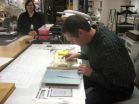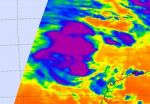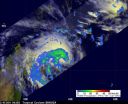(Press-News.org) University of Arizona researchers have cracked one of the puzzles surrounding what has been called "the world's most mysterious manuscript" – the Voynich manuscript, a book filled with drawings and writings nobody has been able to make sense of to this day.
Using radiocarbon dating, a team led by Greg Hodgins in the UA's department of physics has found the manuscript's parchment pages date back to the early 15th century, making the book a century older than scholars had previously thought.
This tome makes the "DaVinci Code" look downright lackluster: Rows of text scrawled on visibly aged parchment, flowing around intricately drawn illustrations depicting plants, astronomical charts and human figures bathing in – perhaps – the fountain of youth. At first glance, the "Voynich manuscript" appears to be not unlike any other antique work of writing and drawing.
An alien language
But a second, closer look reveals that nothing here is what it seems. Alien characters, some resembling Latin letters, others unlike anything used in any known language, are arranged into what appear to be words and sentences, except they don't resemble anything written – or read – by human beings.
Hodgins, an assistant research scientist and assistant professor in the UA's department of physics with a joint appointment at the UA's School of Anthropology, is fascinated with the manuscript.
"Is it a code, a cipher of some kind? People are doing statistical analysis of letter use and word use – the tools that have been used for code breaking. But they still haven't figured it out."
A chemist and archaeological scientist by training, Hodgins works for the NSF Arizona Accelerator Mass Spectrometry, or AMS, Laboratory, which is shared between physics and geosciences. His team was able to nail down the time when the Voynich manuscript was made.
Currently owned by the Beinecke Rare Book and Manuscript Library of Yale University, the manuscript was discovered in the Villa Mondragone near Rome in 1912 by antique book dealer Wilfrid Voynich while sifting through a chest of books offered for sale by the Society of Jesus. Voynich dedicated the remainder of his life to unveiling the mystery of the book's origin and deciphering its meanings. He died 18 years later, without having wrestled any its secrets from the book.
Fast-forward to 2009: In the basement underneath the UA's Physics and Atmospheric Sciences building, Hodgins and a crew of scientists, engineers and technicians stare at a computer monitor displaying graphs and lines. The humming sound of machinery fills the room and provides a backdrop drone for the rhythmic hissing of vacuum pumps.
Stainless steel pipes, alternating with heavy-bodied vacuum chambers, run along the walls.
This is the heart of the NSF-Arizona AMS Laboratory: an accelerator mass spectrometer capable of sniffing out traces of carbon-14 atoms that are present in samples, giving scientists clues about the age of those samples.
Radiocarbon dating: looking back in time
Carbon-14 is a rare form of carbon, a so-called radioisotope, that occurs naturally in the Earth's environment. In the natural environment, there is only one carbon-14 atom per trillion non-radioactive or "stable" carbon isotopes, mostly carbon-12, but with small amounts of carbon-13. Carbon-14 is found in the atmosphere within carbon dioxide gas.
Plants produce their tissues by taking up carbon dioxide from the atmosphere, and so accumulate carbon-14 during life. Animals in turn accumulate carbon-14 in their tissues by eating plants, or eating other organisms that consume plants.
When a plant or animal dies, the level of carbon-14 in it remains drops at a predictable rate, and so can be used to calculate the amount of time that has passed since death.
What is true of plants and animals is also true of products made from them. Because the parchment pages of the Voynich Manuscript were made from animal skin, they can be radiocarbon-dated.
Pointing to the front end of the mass spectrometer, Hodgins explains the principle behind it. A tiny sample of carbon extracted from the manuscript is introduced into the "ion source" of the mass spectrometer.
"This causes the atoms in the sample to be ionized," he explained, "meaning they now have an electric charge and can be propelled by electric and magnetic fields."
Ejected from the ion source, the carbon ions are formed into a beam that races through the instrument at a fraction of the speed of light. Focusing the beam with magnetic lenses and filters, the mass spectrometer then splits it up into several beams, each containing only one isotope species of a certain mass.
"Carbon-14 is heavier than the other carbon isotopes," Hodgins said. "This way, we can single out this isotope and determine how much of it is present in the sample. From that, we calculate its age."
Dissecting a century-old book
To obtain the sample from the manuscript, Hodgins traveled to Yale University, where conservators had previously identified pages that had not been rebound or repaired and were the best to sample.
"I sat down with the Voynich manuscript on a desk in front of me, and delicately dissected a piece of parchment from the edge of a page with a scalpel," Hodgins says.
He cut four samples from four pages, each measuring about 1 by 6 millimeters (ca. 1/16 by 1 inch) and brought them back to the laboratory in Tucson, where they were thoroughly cleaned.
"Because we were sampling from the page margins, we expected there are a lot of finger oils adsorbed over time," Hodgins explains. "Plus, if the book was re-bound at any point, the sampling spots on these pages may actually not have been on the edge but on the spine, meaning they may have had adhesives on them."
"The modern methods we use to date the material are so sensitive that traces of modern contamination would be enough to throw things off."
Next, the sample was combusted, stripping the material of any unwanted compounds and leaving behind only its carbon content as a small dusting of graphite at the bottom of the vial.
"In radiocarbon dating, there is this whole system of many people working at it," he said. "It takes many skills to produce a date. From start to finish, there is archaeological expertise; there is biochemical and chemical expertise; we need physicists, engineers and statisticians. It's one of the joys of working in this place that we all work together toward this common goal."
The UA's team was able to push back the presumed age of the Voynich manuscript by 100 years, a discovery that killed some of the previously held hypotheses about its origins and history.
Elsewhere, experts analyzed the inks and paints that makes up the manuscript's strange writings and images.
"It would be great if we could directly radiocarbon date the inks, but it is actually really difficult to do. First, they are on a surface only in trace amounts" Hodgins said. "The carbon content is usually extremely low. Moreover, sampling ink free of carbon from the parchment on which it sits is currently beyond our abilities. Finally, some inks are not carbon based, but are derived from ground minerals. They're inorganic, so they don't contain any carbon."
"It was found that the colors are consistent with the Renaissance palette – the colors that were available at the time. But it doesn't really tell us one way or the other, there is nothing suspicious there."
While Hodgins is quick to point out that anything beyond the dating aspect is outside his expertise, he admits he is just as fascinated with the book as everybody else who has tried to unveil its history and meaning.
"The text shows strange characteristics like repetitive word use or the exchange of one letter in a sequence," he says. "Oddities like that make it really hard to understand the meaning."
"There are types of ciphers that embed meaning within gibberish. So it is possible that most of it does mean nothing. There is an old cipher method where you have a sheet of paper with strategically placed holes in it. And when those holes are laid on top of the writing, you read the letters in those holes."
"Who knows what's being written about in this manuscript, but it appears to be dealing with a range of topics that might relate to alchemy. Secrecy is sometimes associated with alchemy, and so it would be consistent with that tradition if the knowledge contained in the book was encoded. What we have are the drawings. Just look at those drawings: Are they botanical? Are they marine organisms? Are they astrological? Nobody knows."
"I find this manuscript is absolutely fascinating as a window into a very interesting mind. Piecing these things together was fantastic. It's a great puzzle that no one has cracked, and who doesn't love a puzzle?"
INFORMATION:
High-resolution images of the manuscript's 240 pages, including a special section on highlights and special features, are online at http://voynichcentral.com/gallery
University of Arizona experts determine age of book 'nobody can read'
While enthusiasts across the world pored over the Voynich manuscript, penned by an unknown author in a language no one understands, a research team at the University of Arizona solved one of its biggest mysteries: When was the book made?
2011-02-14
ELSE PRESS RELEASES FROM THIS DATE:
Powerful new ways to electronically mine research may lead to scientific breakthroughs
2011-02-14
The Internet has become not only a tool for disseminating knowledge through scientific publications, but it also has the potential to shape scientific research through expanding the field of metaknowledge—the study of knowledge itself.
The new possibilities for metaknowledge include developing a better understanding of science's social context and the biases that can affect research findings and choices of research topics, according to an article published by University of Chicago researchers in the journal Science. Pooling research-related information online can shed ...
Roses get celery gene to help fight disease
2011-02-14
A rose by any other name would smell … like celery?
North Carolina State University research intended to extend the "vase life" of roses inserts a gene from celery inside rose plants to help fight off botrytis, or petal blight, one of the rose's major post-harvest diseases.
Some fungal pathogens, the bad guys that infect plants, produce a sugar alcohol called mannitol that interferes with the plant's ability to block disease like petal blight, which produces wilty, mushy petals – an effect similar to what happens to lettuce when it's been in the crisper too long.
In ...
JPEG for the mind: How the brain compresses visual information
2011-02-14
Most of us are familiar with the idea of image compression in computers. File extensions like ".jpg" or ".png" signify that millions of pixel values have been compressed into a more efficient format, reducing file size by a factor of 10 or more with little or no apparent change in image quality. The full set of original pixel values would occupy too much space in computer memory and take too long to transmit across networks.
The brain is faced with a similar problem. The images captured by light-sensitive cells in the retina are on the order of a megapixel. The brain ...
Study examines phenomenon of women caring for ex-husbands
2011-02-14
COLUMBIA, Mo. – The aging population, 65 years and older, includes nearly 3.8 million divorced men and women, according to the U.S. Census Bureau. Illnesses and end-of-life issues can be particularly difficult for singles without spouses or designated caregivers. A new study from the University of Missouri provides insight into the experiences of exes who care for their former spouses, offering support, assistance with daily tasks and management of health needs.
"The concept of women as caregivers for their ex-husbands is largely unexplored," said Teresa Cooney, associate ...
NASA infrared satellite data gives System 96S a fair shot at becoming a tropical cyclone
2011-02-14
A low pressure area located a couple of hundred miles northwest of Western Australia appears in a better position for development into a tropical cyclone according to infrared NASA satellite imagery. Infrared imagery from NASA's Aqua satellite shows some strong convection in the low, named System 96S.
When Aqua passed over System 96S on Feb. 9 at 17:47 UTC (12:47 p.m. EST), the Atmospheric Infrared Sounder (AIRS) instrument showed some strong convection and strong thunderstorms with very cold cloud-top temperatures around the center of circulation. Those cloud top temperatures ...
WSU researcher designs multilingual instruction materials for world's largest mall
2011-02-14
Housing 1,200 stores, an underwater zoo, a SEGA indoor theme park, an Olympic-size ice rink, a 22-screen Cineplex and the world's largest gold market, the Dubai Mall is a retail marvel that attracts tourists from around the world. Thanks to one Wayne State researcher, its multilingual, multicultural employees are using an efficient, cost-effective instructional process to learn their job duties.
Monica W. Tracey, Ph.D., associate professor of instructional technology and administrative and organizational studies in WSU's College of Education and resident of Farmington ...
2 NASA satellites see a newborn tropical storm near Madagascar
2011-02-14
Forecasters at the Joint Typhoon Warning Center were keeping a close eye on a low pressure area known as System 94S yesterday, and satellite data helped confirm that today it has strengthened into Tropical Storm Bingiza.
The Moderate Resolution Imaging Spectroradiometer (MODIS) instrument aboard NASA's Terra satellite captured this image of Tropical Storm Bingiza at 06:30 UTC (1:30 a.m. EST) on its approach to Madagascar. The highest, strongest thunderstorms appeared almost bubble-like near the center of the storm's circulation.
The Tropical Rainfall Measuring Mission ...
321Soft Announces New Release of Data Recovery for Mac 5.0.0
2011-02-14
321Soft Data Recovery for Mac is professional and user-friendly Mac data recovery software to recover data lost due to accidental deleting, formatting, virus infection, unexpected power failure, and other unknown reasons. It compatible with HFS+, FAT16/32, NTFS ISO9660, UDF, and EXT2/3 file system volumes, It is non-destructive data recovery software and will not write or make changes to the drive it is recovering from. all recovered files must be saved to another storage device or another drive letter in the system.
Key Features of 321Soft Data Recovery for Mac 5.0.0 ...
Changing views about saturated fat and cardiovascular disease
2011-02-14
(Rosemont, IL) Feb. 10 – For generations, the consumption of dairy products has been positively associated with the health and wellness of families and communities. Nevertheless, the recent shift in dietary trends has focused on "what not to eat" instead of emphasizing "what to eat," resulting in demonizing the naturally occurring fats in dairy, while overlooking its many essential nutrients.
However, the long-held beliefs about the impact of saturated fatty acids (SFA) on the risk of cardiovascular disease (CVD) are being challenged by a new perspectives paper from ...
123Decal Acquires The Banner Factory.
2011-02-14
123Decal a consistent leader in the Custom Decal industry has recently announed the aquistion of The Banner Factory.
The Banner Factory is a wholesale provider of Custom Banners, Vinyl Banners Flag Banners and More. They have provided banners to clients locally as well as on a national basis. Althought the details of the aquisition were not yet available, it is rumored that 123Decal is looking to expand their product lines after explosive growth in the custom decal industry.
123Decal just finished a year of their highest sales in company history. They are well position ...
LAST 30 PRESS RELEASES:
Coffee as a staining agent substitute in electron microscopy
Revealing the diversity of olfactory receptors in hagfish and its implications for early vertebrate evolution
Development of an ultrasonic sensor capable of cuffless, non-invasive blood pressure measurement
Longer treatment with medications for opioid use disorder is associated with greater probability of survival
Strategy over morality can help conservation campaigns reduce ivory demand, research shows
Rising temperatures reshape microbial carbon cycling during animal carcass decomposition in water
Achieving ultra-low-power explosive jumps via locust bio-hybrid muscle actuators
Plant-derived phenolic acids revive the power of tetracycline against drug-resistant bacteria
Cooperation: A costly affair in bacterial social behaviour?
Viruses in wastewater: Silent drivers of pollution removal and antibiotic resistance
Sub-iethal water disinfection may accelerate the spread of antibiotic resistance
Three in four new Australian moms struggle with body image
Post-stroke injection protects the brain in preclinical study
Cardiovascular risk score predicts multiple eye diseases
Health: estimated one in ten British adults used or interested in GLP-1 medications for weight loss
Exercise to treat depression yields similar results to therapy
Whooping cough vaccination for pregnant women strengthens babies’ immune system
Dramatic decline in new cases of orphanhood in Uganda driven by HIV treatment and prevention programs
Stopping weight loss drugs linked to weight regain and reversal of heart health markers
Higher intake of food preservatives linked to increased cancer risk
Mass General Brigham–developed cholera vaccine completes phase 1 trial
First experimental validation of a “150-year-old chemical common sense” direct visualization of the molecular structural changes in the ultrafast anthracene [4+4] photocycloaddition reaction
Lack of support for people on weight loss drugs leaves them vulnerable to nutritional deficiencies, say experts
Dogs’ dinners can have greater climate impact than owners’
Are you ready to swap salmon for sprats and sardines?
1.6 million UK adults used weight loss drugs in past year
American College of Cardiology comments on new dietary guidelines for Americans
American Society of Gene & Cell Therapy and Orphan Therapeutics Accelerator partner to advance and commercialize promising rare disease treatments
One in 14 patients having day case surgery have new or worse chronic pain 3 months after their operation
New study highlights link between eviction rates and gun violence
[Press-News.org] University of Arizona experts determine age of book 'nobody can read'While enthusiasts across the world pored over the Voynich manuscript, penned by an unknown author in a language no one understands, a research team at the University of Arizona solved one of its biggest mysteries: When was the book made?





